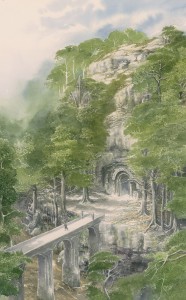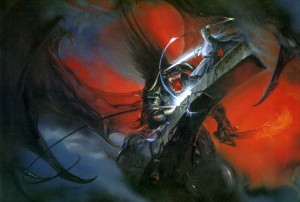More, elves in the First Age were often poor record keepers:
 “By the Naugrim the Cirth were taken east over the mountains and passed into the knowledge of many peoples; but they were little used by the Sindar for the keeping of records, until the days of the War, and much that was held in memory perished in the ruins of Doriath.” The Silmarillion, Of the Sindar.
“By the Naugrim the Cirth were taken east over the mountains and passed into the knowledge of many peoples; but they were little used by the Sindar for the keeping of records, until the days of the War, and much that was held in memory perished in the ruins of Doriath.” The Silmarillion, Of the Sindar.
And it’s not hard to conclude that this is one of the themes of the First Age. Every setback for the Noldor is not simply a blow against their forlorn hopes to overcome Morgoth, it’s another diminution of their collective memory — part of a piecemeal destruction of culture, knowledge and history.
So many elves — both Sindar and Noldor — get (to employ the vernacular) toasted in that long, vain war to reclaim the Silmarils from Morgoth. In fact, it’s easier to list those who survive than those who perish before the Valar finally show up to haul them out of the fire.
(For the record, of the dominant players in that long, bitter war, my shortlist of survivors amounts to Cirdan, Elrond, Gil-galad, Celeborn and Galadriel — and the middle two play only a small role in later events, while the latter pair left Beleriand either before, or in the wake of the ruin of Doriath.)
Plus many of the few remaining Exiles who survived the War of Wrath chose to return to Valinor.
The Second Age and Third Age are similarly chaotic — much is created but even more is destroyed in in conflict, or just lost in the mists of time.
Is it any surprise that our knowledge of Middle-earth is so contradictory and incomplete as a result?
Of course, there are exceptions. One is Pengolodh the Loremaster, who escaped the sack of Gondolin and then compiled the oral traditions, legends and stories that would eventually form the basis of the Quenta Silmarillion. This is the Quenta that later forms the basis of Bilbo’s translations of elvish that descend to us via the Red Book of Westmarch.
Pengolodh later survives the destruction of Eregion in the Second Age (lucky guy!) before deciding enough is enough and heading off to Valinor.
Incompleteness generates verisimilitude
But to return to my point: all this messiness is actually really, really cool.
 Just think: without this historical haziness there would be no Bombadil debates, no Balrog wing discussions, no asking “just where the hell did Hobbits come from?”.
Just think: without this historical haziness there would be no Bombadil debates, no Balrog wing discussions, no asking “just where the hell did Hobbits come from?”.
Instead of swapping theories we’d just have bald restatement of whatever Tolkien settled on. And by golly that would be ever-so-dull.
Of course, some of this ambiguity is inadvertent — the result of Tolkien discarding stories mid-draft for reasons only known to himself.
But read Leaf by Niggle and you begin to understand Tolkien was also aiming for this sort of effect. As he divulges in Letter #154 in The Letters of JRR Tolkien, it is “an elaborate form of the game of inventing a country — an endless one, because even a committee of experts in different branches could not complete the overall picture.”
And I wonder if that is not one of the most astute decisions he ever made as a writer.
So I encourage you to enjoy the journey through Tolkien’s world. Because half the wonder of it is that you’ll never truly, and definitely, reach the destination.
Demosthenes has been an incredibly nerdy staff member at TheOneRing.net since 2001. The views (and wacky theories) in this article are his own, and do not necessarily represent those of other TORn staff.


